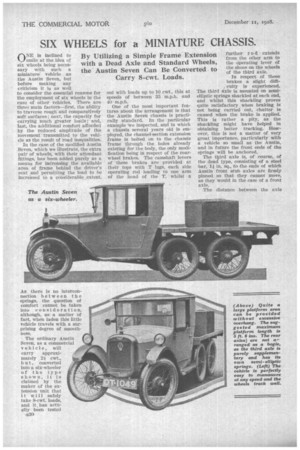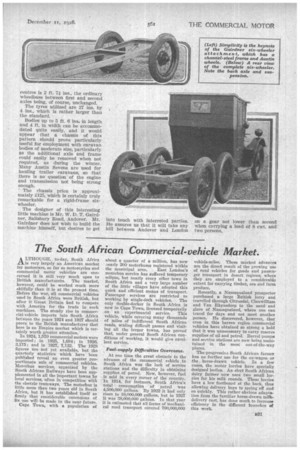SIX WHEELS for a MINIATURE CHASSIS.
Page 14

Page 15

If you've noticed an error in this article please click here to report it so we can fix it.
By Utilizing a Simple Frame Extension with a Dead Axle and Standard Wheels, the Austin Seven Can Be Converted to Carry 8-cwt. Loads.
(-NNE is inclined to N.,./smile at the idea of six wheels being necessary with such a miniature vehicle as the Austin Seven, but before making any criticism it is as well to consider the essential reasons for the employment of six wheels in the case of other vehicles. There are three main factors—first, the ability to traverse rough arid comparatively soft surfaces; next, the capacity for carrying much greater loads; ' and, last, the additional comfort afforded by the reduced amplitude of the movement transmitted tothe vehicle as the result of road inequalities.
In the case of the modified Austin Seven, which we illustrate, the extra pair of wheels; with their attendant fittings, has been added purely as a means for increasing the available area of frame behind the driver's seat and permitting the load to be increased to a considerable ,extent.
As there is no interconnection between the springs, the question of comfort cannot be taken into consideration, although, as a matter of fact, when laden this little vehicle travels with a surprising degree of smoothness.
The ordinary Austin Seven, as a commercial vehicle, will carry approximately 2i cwt., but, converted Into a six-wheeler of the type shown, it is claimed by the maker of the extension unit that it will safely take 8-cwt. loads, and it has actually been tested
,B30
out with loads up to 10 cwt., this at speedS of between 35 m.p.h. and 40 m.p.h.
One of the most important features about the arrangement is that the Austin Seven chassis is practically standard. In the particular example we inspected, and in which a chassis several years old is employed, the channel-section extension frame is bolted on to the chassis frame through the holes already existing for the body, the only modification being in respect of the rearwheel brakes. The camshaft levers of these brakes are provided at their tops with T lugs, each Side operating rod leading to one arm of the head of the T, whilst a further r o d extends from the other arm to the operating lever of the shoes on the wheels of the third axle.
In respect of these brakes a slight difficulty is experienced. The third axle is mounted on semielliptic springs shackled at each end, and whilst this shackling proves quite satisfactory when braking is not being carried out, chatter is caused when the brake is applied. This is rather a pity, as the shackling might have helped in obtaining better tracking. However, this is not a matter of very great importance, particularly with a vehicle so small as the Austin, and in future the front ends of the springs will be anchored.
The third axle is, of course, of the dead type, consisting of a steel -bar, 1f in. sq., to the ends of which Austin front stub axles are firmly pinned so that they cannot move, as they would in the case of a front axle.
The distance between the axle centres is 2 ft. 71 ins., the ordinary wheelbase between hrst and second axles being, of course, unchanged.
The tyres utilized are 27 ins. by 4 ins., which is rather larger than the standard.
Bodies up to 5 ft. 6 ins, in length and 4 ft. in width can be accommodated quite easily, and it would appear that a chassis of this pattern should prove particularly useful for employment with caravan bodies of moderate size, particularly as the additional axle and frame could easily be removed when not required, as during the winter. Many Austin Sevens are used for hauling trailer caravans, so that there is no question of the engine and transmission not being strong enough.
The chassis price is approximately £125, which is certainly truly remarkable for a rigid-frame sixwheeler.
The designer of this interesting little machine is Mr. W. D. T. Gairdner, Salisbury Road, Andover. Mr. Gairdner does not wish to build the machine himself, but desires to get into touch with interested parties. He assures us that it will take any hill between Andover and London on a gear not lower than second when carrying a load of 8 cwt. and two persons.






























